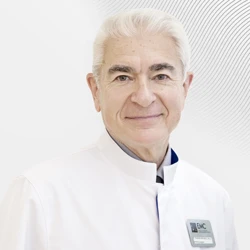What is a stoma?
An intestinal stoma is a surgically formed opening in the anterior abdominal wall to drain feces, bypassing the natural path through the intestines. Such a need arises in the treatment of various diseases of the colon and small intestine, when restoring intestinal continuity after surgery is not possible. The most common types of intestinal stomata in coloproctology are ileostomy (connects the lumen of the lower part of the small intestine to the skin surface) and colostomy (connects the lumen of the large intestine to the skin surface).
Causes of intestinal stoma formation
When forming an stoma, the surgeon strives to solve the following tasks:
- Restore the discharge of stool and gases (in case of intestinal obstruction);
- Compensate for the loss of rectal function;
- Temporarily stop the flow of feces into the rectum after performing surgery on the colon or rectum to create an anastomosis (connecting parts of the intestine) or in case of pelvic injuries (damage to the rectum in pelvic fractures, severe childbirth, direct trauma, etc.). Stoma removal relieves the patient of prolonged suffering and pain and is in some cases only a temporary measure designed to solve urgent problems caused by the disease and prepare the patient for reconstructive surgery.
The majority of stoma patients are people over the age of 50 who have undergone surgery for malignant neoplasms of the colon and rectum. However, cancer is not the only cause of stoma formation: there are younger patients who have been operated on for ulcerative colitis and Crohn's disease, familial intestinal polyposis, diverticular disease and injuries complicated by intestinal obstruction or peritonitis. For most of them, a stoma is a temporary measure, but some patients have to live with a stoma for many years.
If the formation of a stoma occurs as planned, patients, as a rule, agree to such a result of surgery, because they know that after a certain time the stoma will be eliminated. Usually, after the closure of temporary stomata, intestinal functions are fully restored.
On the other hand, removing a permanent stoma creates a whole range of technical and psychological problems for the patient. The fact of stoma formation is even more difficult in the case of emergency surgery for acute intestinal obstruction, tumor perforation and bleeding, when the stoma is removed for vital reasons.
A permanent colostomy is inevitable if, after intestinal resection, the remaining part of the intestine is not enough to connect a healthy area to the anus and ensure the natural functioning of the intestine.
The need to form a permanent stoma most often occurs when performing the so-called abdominal-perineal extirpation of the rectum, when the rectum, anal canal and anal sphincter muscles are completely removed, as well as as a result of total colopectomy in severe Crohn's disease and ulcerative colitis.
The attention and participation of the doctor in informing and educating the patient, as well as the availability of modern stoma care products, allow most patients to subsequently maintain their working capacity and habitual daily activity. A number of clinics have established centers that employ staff who specialize in the care of stoma patients and teach them the rules of stoma care.
Reconstructive surgery in patients with stoma
Modern possibilities of colorectal surgery are increasingly making it possible to positively address the issue of performing reconstructive surgery in patients whose volume of surgical intervention previously did not imply the technical possibility of restoring intestinal continuity. The qualifications of EMC coloproctology surgeons, the experience of performing such operations and the technical equipment of operating rooms allow performing surgery of any degree of complexity, the only condition is the possibility of reconstructive surgery, which is evaluated individually for each stomatosed patient.
Common questions from patients with ileo- and colostomy
How soon can reconstructive surgery be performed?
The timing of stoma closure depends on many factors: the causes of stoma formation, concomitant diseases, complications after surgery, the general condition and age of the patient. The optimal time for reconstructive surgery is from 2 to 3 months after the formation of the stoma. The greater the "age" of a long-term existing stoma, the more often complications such as cicatricial constriction, prolapse, paracolostomy hernias, fistulas and abscesses occur, which technically complicate the operation.
How can I determine if reconstructive surgery is possible?
In order to determine the prospects and possibility of reconstructive surgery to close the stoma, a thorough examination of the patient is necessary. The condition of both functioning and disabled colon sections should be assessed. For this purpose, the patient undergoes colonoscopy/colonography/irrigoscopy, CT of the abdominal and thoracic organs, and MRI of the pelvis (especially important for patients undergoing surgery for malignant neoplasms in order to exclude recurrence and metastasis of the tumor).
If the stoma was removed as a result of surgery for ulcerative colitis, it is necessary to examine the preserved areas of the intestine for the transformation of the inflammatory process into cancer, as well as to assess the preservation of the function of the anal canal and sphincter. Only after a full examination is a certain amount of surgical intervention planned.
How is the operation going?
The essence of reconstructive surgery — closure of the stoma — is to restore the continuity of the intestine by connecting the ends of the remaining parts of the intestine — creating a so-called anastomosis, the reliability of which is ensured by modern stapler staplers.
Technical difficulties during the operation may be associated with cicatricial-adhesive processes in the abdominal cavity, as well as with the small size of the remaining part of the rectum or with its complete absence. In such cases, modern techniques provide for rectal plastic surgery, and in most cases it is possible to restore adequate function of retention and discharge.
EMC coloproctologists have experience in reconstructions of the intestine from 3-4 months to 10 years after the formation of a stoma, including in patients with a "load" of concomitant diseases. The problems of therapeutic preparation of the patient for surgery are successfully solved in a multidisciplinary hospital with the participation of a cardiologist, pulmonologist, nephrologist and other specialists.
Of course, the postoperative period after the closure of the stoma will require getting used to the new mode of bowel function, due to the peculiarities of the operation performed. Motivation to overcome possible problems and comprehensive support from the specialists of the EMC Surgical Clinic will help the patient to find a new, higher quality of life.
Was this information helpful?
Questions and answers
Ask a Question





.webp)







.webp)

.webp)
.webp)





.webp)


